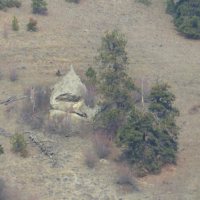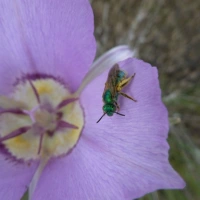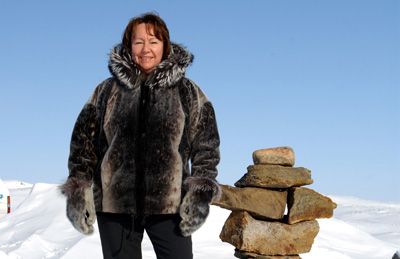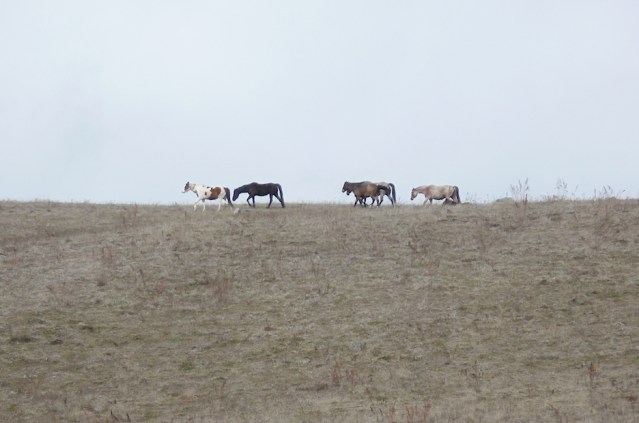The road is long. It is worth travelling. The road is hard. It must be taken. These aren’t proverbs. They are signposts on the road to environmental reconstruction of human social relationships and social reconstruction through rebuilding environmental relationships.The road is in plain sight, but the road is hidden. The journey is to carry light in the dark. The journey is to carry dark in the light.First, though, there has to be the awareness that there is a road. This is the road…
 Early Winter Sun Turns a Young Sage Brush Into Shadow
Early Winter Sun Turns a Young Sage Brush Into Shadow
By the addition of a sidewalk, this native plant has been turned into a weed. The shadow, however, tells the time. It’s late.
I’ll get back to that image, but first some context. On Wednesday, I sat with several hundred people and heard Sheila Watt-Cloutier speak on the relationship between climate change and human rights. Over an hour, she presented the insight that climate change affects the ability of societies to maintain themselves socially and physically. More specifically, she argued that industrialization poisons mothers’ milk (in the Arctic) while at the same time asks that the path presented out of the social loss caused by industrialization’s removal of peoples from their land is through employment in resource extraction industries, namely mining and petroleum. In other words, industrialization often urges people to suppress their cultures and their identities and to represent this suppression in the destruction of landscapes that once sustained them physically, socially and spiritually. Here’s a shorter version of her speech, in which she argued, passionately, for her people’s right to be cold:
Sheila Watt-Cloutier Speaks on the Environment and Human Rights. Source.
Sheila Watt-Cloutier asked for our support as fellow Canadians to rectify a slide into global environmental catastrophe by providing social leadership, within our country, to preserve cultural ties to the land. As I understood that, her deep meaning was that if indigenous ties to the land were preserved, the natural world would also remain in balance, and, what’s more, that through such leadership Canada could play a strong role in maintaining a natural balance in the community of world cultures and through that in the state of the planet as a whole. She was, I believe, offering an opportunity for Canada in the world.
Sheila Watt-Cloutier
Speaks on the human right to be cold, and so much more. Source.
I would like to extend Sheila Watt-Cloutier’s comments into a broader discussion of landscapes. If it is the right of indigenous people to have a culture, and if the destruction of that culture is a form of denial of a universal human right, and I accept her argument fully, then it’s not just about her Arctic but about all human cultures. In the grasslands of the North American west, for instance, from which I am writing this note, this means that the area’s indigenous people, the Syilx of the Columbia Plateau, have several inalienable rights: the right to grasslands, the right to salmon, the right to travel freely over the entire Plateau, among many others.
Okanagan Indian Band Horses on Band Range
Traditional culture need not be frozen in time. The arrival of the horse among the Plateau peoples around the time of American expansion into the Ohio Valley to the East, and the consequent unsettling of Plains culture and the resulting demographic pressures pushing inexorably towards the west profoundly altered Plateau culture, for better and for worse, but it did not in any way destroy a primary relationship with place and identity. It just pushed it towards greater individualization and competition, within the broader sense of the landscape. It is telling that the settlement of Plateau people into reservations, to break their land sense, came along at the same time at which their horses were shot, tinned as dog food and shipped to the American East. That was not an act of adaptation. We can do better.
It’s not just the Syilx, either, who have a human right to the land, but all people whose identity is intimately linked to it, and here’s the core of that: that’s everyone.
Staghorn Sumac in the Spring
When these fruiting spurs are ripe in the fall, they can be used to make an indigenous lemonade that is tart and sweet, fruity and astringent, and sooooooo good.
If the Syilx could adopt the horse to traditional culture without losing traditional culture, then my farming culture can just as easily adopt sumac, and transform itself into a more cooperative relationship with both the land and the Syilx, and indeed with North American indigenous cultures in general. A couple comments I overheard as the largely academic crowd was dispersing should serve to highlight some of the parameters and difficulties of this approach. The first comment was:
“She talks about living off the land, but that’s impossible. There are too many of us to do that anymore.”
Expressed With Great Frustration and Irritation by a Man in His Late Fifties, Who then Left in a Huff
In answer, I would like to suggest that, in fact, it hasn’t been tried. Indigenous methods of agriculture have never been adopted in the West. Cattle ranching is the closest we’ve come, and interestingly enough, it is a culture that remains solid in both settler and indigenous culture and which allows both of them to remain in contact with individual relationships with the land. It has problems, but they are not fundamentally insolvable. In fact, the grasslands of the Cariboo-Chilcotin, the last remaining complete, pristine grasslands on temperate earth, remain today because of large-scale cattle ranching, which lives very lightly upon the land and relies on its natural productivity.
Cariboo Chilcotin Grassland
North of Dog Creek, looking West from the Cariboo, over the mid-Fraser River Canyon, to the Chilcotin, the Gang Ranch, and the mountains of the Chilcotin Arc to the South and West. This form of agriculture is capable of supporting settler and indigenous cultures and the land itself. It has problems, including deep problems with land ownership issues, but it is one model. It is not the only one.
A hundred and twenty years ago, the Okanagan looked like the above image. Now much of it looks like this:
A point of national pride. Note the flag. Wait, why should this be a matter of pride? Wouldn’t pride mean that we work together to build wealth? For everyone? Wouldn’t it mean that the imposition of Canadian government on this place had brought wealth and prosperity? For this place? For that man there in his camo pants at dusk, looking at the door as if he were out deer hunting?
The thing is, sadly, that in the main the landscape has been industrially altered in order to support, in certain select areas, European agriculture. Water is removed from the land, the life it might have been supported is allowed to vanish or to go to weeds, the animals that could support populations are considered vermin …
Vermin
From a social perspective, shooting Syilx deer for a) eating apple shoots and b) not running away when people go out walking (yes, this is a current controversy in town) is violence done to Syilx culture, and, ultimately, to the Syilx, in a way that respectfully shooting them for needed food would not be.
… and if the economic model should collapse, as indeed it likely will due to the nature of the misfit of capital reinvestment with human generational change (accelerated by systems of innovation which lure the young away to distant urban centres), then the land is ripe for redevelopment as a strip mall:
Orchard in Oliver, British Columbia
By leaving formerly productive land as stumps, a landowner can make the argument that it is not agricultural land but only suitable for redevelopment, whereas in fact the agricultural failing was only a failure of a distribution model, or perhaps of crop choice. Still, the orchard right next door just became a strip mall. The writing is on the wall, despite legislative protection for land such as this.
The problem with this form of cultural succession is simple: we all live off the land. There is nothing else. If food does not come from the land, there is no food, unless, of course, we take it from other people, which is, again, an issue of human rights. One of the positive messages given by Sheila Watt-Cloutier is that legislation lasts if it has cultural roots. In other words, it is cultural work which will save the land —which will, in turn, save us from ourselves. In this respect, the second comment I overheard in the exodus from Sheila Watt-Cloutier’s presentation was equally telling. Here it is, as I remember it:
“The images [in her slide show] went by too slowly. She promised to present both images of people and the land, but we had to wait to the end to see any people at all. Instead of presenting her ideas in depth, she presented one idea over and over again, without increasing sophistication. It was as if she was talking to a high school class, or a group of people who did not know anything of the subject.”
Expressed With Great Frustration and Irritation by a Woman in Her Early Thirties, Who then Left in a Huff
There are some solid criticisms here, as well as some misconceptions. In the tradition of Western academic scholarship (the speech was sponsored by the University of British Columbia), the speech lacked the solid academic touchstones which this young, obviously academic woman was looking for. The points are well taken. I am not so certain, however, that she picked up on the other messages, which included these:
1.) Sheila Watt-Cloutier argued for the right of the Inuit to continue their hunting cultures, which taught, among other things, patience. The pacing of the images was, indeed slow, but had its own elegance and made its own demands for patience. That the images did not go away at the speed at which contemporary visual imaginations expect was demanding, and, in an important way, independent of the human and social argument Sheila Watt-Cloutier was making.
2.) Conversely, the images were human faces. A people who live in intimate relationship with the land are the land and the land is them. That is, in fact, their human right as indigenous people. What’s more, the faces of the people who closed the presentation were faces of the land. There is no separation.
3.) Sheila Watt-Cloutier was speaking as an Inuk, not as an academic. Respect, as practiced among aboriginal peoples, would ask that her comments be read within her context, I believe this was precisely the point she was making about global industrial pollutants concentrating in the Arctic and finding their most toxic purification in the breast milk of inuit mothers, right at the point at which there should be the greatest amount of life.
As for the lack of specificity or extension, perhaps that’s up to the rest of us. Indeed, Mrs. Watt-Cloutier asked for just this. A third response I overheard was one that was actually directed publicly, as a question from the audience. It went something like this:
“Why do you think there is a disproportionate number of indigenous people from around the world who care for the land, in comparison to the rest of us, Europeans? Is it a genetic thing? What’s your opinion?”
Question Asked of Sheila Watt-Cloutier by a Man in His Late Fifties
Mrs. Watt-Cloutier answered the question with respect for the concern at its heart, by pointing out (and I paraphrase here from memory) that it’s not a question of indigenous people being different from anyone else but that most people today live in cities and have lost close contact with their land. She pointed out that some two hundred and fifty years ago almost everyone was intimately connected with land. In other words, and these are my thoughts here, indigenous life is not inaccessible for most people and is a part of their not-so-distant family and cultural pasts. I’d just like to add that it can also be very close to our present. Which brings me back to my road. Here it is again:
After the Snow
But not after the water shadow and light shadow that still operate on this old grassland. The sun and the earth are still doing their old magic.
Four inches of snow, or about 8 mm of water, drained away the other day from this former productive hillside, entered the storm sewer system, and wound up down at the valley bottom, months ahead of schedule and without doing any work along the way. Over the course of the winter, we can expect a total of one metre of snow to fall, although most of the time no more than a few centimetres, if any, will remain on the ground. Over the course of the year, twenty-five centimetres of water will fall on this land. Breaking that down, it means that for every kilometre of road in this single subdivision, about 98 cubic metres of water fall from the sky and are whisked away. The same applies for every other of the thousands of kilometres of roads in town. This water is used to keep the lake level high in the valley below, where it needs to be …
Lower BX Creek Estuary, Okanagan Lake
… so that high country water, that would naturally maintain the lake level, can be siphoned off into industrial and residential uses. It doesn’t, however, need to be this way, not exactly. The plants, for example, are showing us something that is not yet integrated with this model of industrial efficiency:
Shade Matters
Water stays when it’s out of the light, and snow stays when it is shovelled in piles.
Instead of tens of thousands of kilometres of water lines siphoning all this precious water away, why aren’t we shoveling it into storage tanks, built under sidewalks, from which it can be pumped in the summer? Or, where aren’t we otherwise using it before giving it to the lake? That’s the way the land works here. 93 cubic metres of water per kilometre of street (200 houses if both sides of the street are built up with 10 metre frontage per house) means that every kilometre of street could collect enough water to fill a tank 1.57 metres in diameter and 5 metres long. That’s enough water to do something with. It could be used in place and then delivered to the lake, with likely no more loss to the atmosphere than is currently lost to evaporation. What if that water were used to grow watercress (in water 2.5 centimetres deep?) The gravity of the hillsides could move the water through the beds, and city streets could become productive agricultural farms for a price far less than the current price for agricultural land, which must compete for space with real estate development. A model that united both land uses would be respectful (at least to a greater degree than the present) of both Syilx and settler culture and of the grasslands. Better yet, and with deeper respect for the land and its people, the water could be used to grow many other crops, including indigenous ones, along the way. Anything is possible: the water, the hills, the gravity, the plants, the sun, they are all there, as they always have been. Water-conserving food plants have not genetically vanished from this landscape. All the pieces are here. All the stands between them and life is an idea. Sheila Watt-Cloutier has made the challenge that we accept the human consequences of our ideas and reshape them to allow for cultural and environmental survival. She makes no distinction between the two. The consequences in her culture, she says, of not doing so, are youth suicide, substance abuse, poisonous environments, spiritual poverty, and other serious social issues, which are expensive to fix. The profits for industry, in other words, come, ultimately from the same source as our food: from our land, and from our people. There is nothing else. There is no other place for it to come from.
 Combined Hydroponics Shop, Church, and Bowling Alley Parking Lot
Combined Hydroponics Shop, Church, and Bowling Alley Parking Lot
Vernon
Better than Nature? That’s a cultural and spiritual question. Without Nature? That’s not possible. It means without us. And by us I mean the community of living things on this planet.
Vermin?
Some of our brothers and sisters near Daisy, Washington, on the shore of the impounded Columbia River, upstream from the Grand Coulee Dam. The peach orchards of Daisy are all underwater now. The salmon are extirpated.
What might have been is gone. The disrespect that was embedded in it, remains, visible for all. The potential for healing through life remains. Let’s use our intellectual resources to get there, even if it means transforming the nature of intellectual culture to get there by adopting the inclusiveness of Sheila Watt-Cloutier.

























Your poetic metaphoric way of embracing the land, the journey and your revelation of the land’s story / possibility inspires — bringing a gentleness of loving vision to the tragedy of our commons — I have often imagined that migratory peoples attempt to recreate the landscape of their ancestors in a kind of blindness to unfamiliar landscapes — we will only behold this folly as we grow new personal/ communal / cultural organs of perception — listening to the landscapes elders is crucial — listening to the land itself — gratitudes for the ongoing grace that you bring to the work
LikeLike
Thanks! Knowing that you and others are walking this road with me makes all the difference.
LikeLike
“A people who live in intimate relationship with the land are the land and the land is them” – beautiful!
LikeLike
Thanks!
LikeLike
Harold, I like very much to read your ponderings on the land, our path and in the case of last week’s talk in Vernon, the message contained therein. I too was there, and felt the message and what I expected to hear, conflicted with the presentation I heard. I was like some you quoted, but with another feeling. Why was capitalism and our economic model not the overt subject of critique? It seemed missing from the talk…not like the message that Wade Davis the previous UBCO guest speaker had so clearly enunciated. I felt the white elephant in the room needed to be ‘outed’.
I sincerely wish to live in a manner respectfully with the seasons, and in line with our human nature which seeks to live more in harmony with the earth, and not be forced to be enslaved to money, survival in urban settings and a culture of consumerism and lack. We, who make up the current ‘settler’ population suffer with our discontent, trying to buy or scratch out a illusive happiness, knowing we are doing so unsustainably. What Sheila Watt-Cloutier was speaking to was the current reality facing her Inuit people wherein they are being compelled to make a choice as to following further this path of urbanisation and separation from nature and cultural inheritance and values, or to stay the course, of not having the wealth in money, and yet having more of the wealth in the enviroment. All the while getting the consequences of global warming without the benefits. What a story to live within. I left both saddened and validated, in that I recognise the choices facing us in our current society are uniquely disempowering and sickness causing…as the empires fail. When we regain a healthy relationship to the earth, recreate our relationship to wealth and the natural environment, thru monetary reform and reorientation to long term sustainable forms of ‘economy’ then perhaps we on our lovely planet can find peace…but while we build traps such as nuclear power plants near Tsunami prone locales, and pipelines to fulfill the extraction of the earth’s wealth, we are doomed to make the same mistakes. What will it take to turn the ship around? Why does it seem that human nature requires us to feel pain before we are motivated to change our behaviour?
LikeLike
Thanks, Carol,
oh, I felt that the message regarding capitalism was loud and clear. Remember that in traditional systems of respect, the discussion doesn’t need to be so overt. In fact, when pushed in that direction, she strenuously avoided comment. Her message was, perhaps, low key, but it had its own force: we are poisoning ourselves and are being forced to choose the poison. It wasn’t just a message regarding the Inuit, however. It was universal. I was raised in settler culture, but I have left it, long ago, and am working hard at creating alternate narratives. Ultimately, the narrative will have to be one in which industrial cultures embrace the indigenous within themselves, rather than projecting it on others. It’s safe out there. It’s transformative when it’s a part of yourself. Of course, it’s not easy, and even these words “I” and “we” are terribly inadequate when dealing with concepts of unity and land. But, still, I volunteered for two years in a Secwepemc language class in the Cariboo, and learned a universe about respect, what it is, when it is given, how it is given, and when it is withheld, and what they all look like. Speaking directly about the capitalist issue (with its forms of accounting that do not figure the environment or human society into the mix) would have been outside the chain of respect. It is up to the audience, and Wade Davis, and you, and me, to extend that respect into settler terms. I think what Sheila Watt-Cloutier was trying to do was to find an iconic image that would resonate and lead people into realizations of universal peril.In that respect, she was speaking very poetically, although not from the Western tradition. And poets have always need commentators. As for the nuclear power plant, the idea of my blog is to build up evidence for a way of using natural energy systems so that the plants at Hanford do not need to be restarted, with their terrible local legacy. I hope you keep listening.
best,
Harold
LikeLike